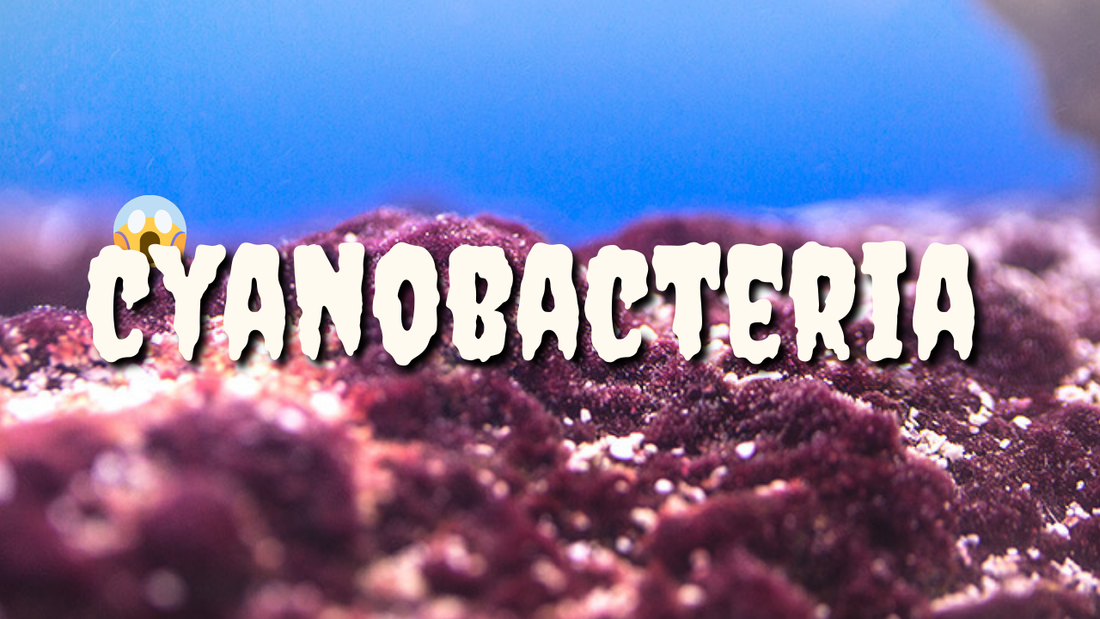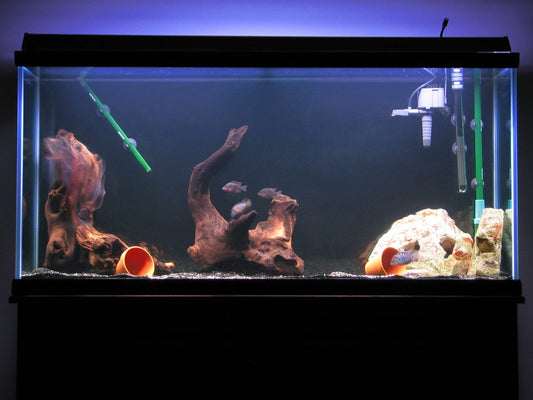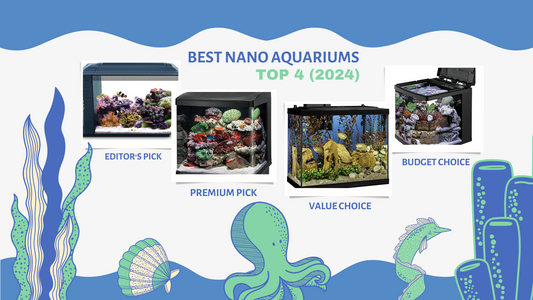How To Get Rid of Cyanobacteria in a Reef Tank

Do you love having a reef tank in your living room? Maintaining a reef tank can be a beautiful and rewarding hobby that showcases the wonders of marine life. But it can also be a nightmare if you have to deal with one of the most annoying and persistent problems: cyanobacteria.
How can you stop cyano from taking over your reef? How can you eliminate it once it shows up?
In this article, we will answer these questions and more. We’ll explain what causes cyanobacteria to grow in reef tanks and what you can do to stop it. We will also share with you some effective methods to remove it from your tank and keep it away for good.
What is Cyanobacteria and Red Slime Algae?
Cyanobacteria, also known as “Blue Green Algae”, “Red Slime Algae“, or “Cyano,”
Now, I know what you’re thinking, “Sir, what the heck is cyanobacteria and why should I care?” Well, my friends, cyanobacteria is a type of photosynthetic organism that can wreak havoc on your aquarium, causing unsightly outbreaks of red algae and that can be a real pain to deal with.
You see, in a healthy and balanced tank, beneficial bacteria and other micro-organisms out-compete cyanobacteria for resources. But when conditions are just right (or, more accurately, just wrong), these little buggers can take over, leaving you with a slimy, smelly mess.
But here’s the thing, cyanobacteria is actually one of the oldest living organisms in the fossil record and exists in diverse environments around the planet. That’s right, they’re tough little buggers that can survive in extreme environments like deserts, polar regions, and even hot springs.
Fun Fact: Cyanobacteria produce oxygen as a byproduct of photosynthesis, making it essential to life on Earth. However, it can also be harmful, causing blooms in polluted ocean areas and posing a danger to marine life.
But don’t panic! There are effective removal techniques, such as manually removing the algae, adding in beneficial bacteria, or using chemical treatments. Just make sure you’re using the appropriate method for your tank and following all instructions carefully.

How to Identify Cyanobacteria
If you and your family frequent lakes in the summer, you’ve probably seen cyano blooms and those warning signs that tell you not to go swimming.
You can find Cyanobacteria colors range from green to purple, although in my tanks it’s always purple or green. While it’s a nuisance, it’s not dangerous to you or your livestock, but if it does cover your photosynthetic corals, it can starve them.

One of the first signs of immense cyanobacteria blooms is the appearance of a slimy or filmy layer on the rocks, sand or glass of the tank. This layer can be different colors, but it is usually red. Some other signs of a cyanobacteria bloom are:
- A foul smell in the tank or the water
- A decrease in the oxygen level in the water
- A decline in the health and color of the corals and other animals
- A rise in the nitrate or phosphate level in the water
But how do you know for sure if you’re dealing with cyanobacteria and not the much-dreaded dinoflagellates? Well, I’ve found that there are three easy ways to identify cyanobacteria.

Color and Appearance – Cyanobacteria are often found in shades of deep red,, purple, or blue-green and can take on a slimy or gelatinous appearance. And if it’s purple, it’s probably cyano.

Growth Pattern – Cyanobacteria tend to grow in thin, flat sheets that often cover large areas of the tank. They can also grow in clumps, which can be easily removed. If it’s spread out like a yoga mat and does this in a day or two, it’s probably cyano.

Detaches Easily – One of the distinguishing characteristics of cyanobacteria is that it detaches easily from the other surfaces it’s growing on. So, if you touch a cyanobacteria patch, it will often come loose and float around the tank.
Even though it covers everything, there are no roots to it. If you attack it with a turkey baster or a power head, it’ll come right off whatever it’s covering.
Causes of Red Slime Algae in Reef Tanks
There are several reasons why cyanobacteria may grow in a tank. One of the most common causes is high nutrient levels, particularly nitrate and phosphate. Excess light exposure can also contribute to the growth of cyanobacteria, as can poor water flow in the tank.

Cyanobacteria growth in a reef tank can be caused by various factors, including:
High Nutrient Levels – Cyanobacteria feed on excess nutrients such as nitrates and phosphates. When these nutrients are present in high levels, cyanobacteria can grow and spread quickly.
Poor Water Circulation – Inadequate water flow in a tank can create dead spots in tap water where cyanobacteria can thrive.
Poor Lighting – Insufficient or improper lighting can also contribute to the growth of cyanobacteria.
Overfeeding – Overfeeding your fish and other organisms in the tank can lead to excess nutrients, which can fuel cyanobacteria growth.
Now, some people say that it is more likely to appear in high nutrient systems, while others say it’s more common in low nutrient systems.

Effective Treatment Methods for Red Slime Algae
Now, we’re talking about how to kick cyanobacteria’s butt! Yeah, that’s right, we’re gonna show that this cyano problem who’s boss, with these two effective treatment methods.
1. Increase Water Flow

“Give your aquarium water a natural wave effect”
First up, step one – increase the water flow. You see, cyanobacteria isn’t exactly the strongest critter out there, so by cranking up the flow in those cyano-prone areas, you can just blow it away like a feather in the wind. Add another powerhead, move your wave maker around, just get rid of those dead spots, and you’ll be saying “bye-bye, cyanobacteria!”
2. Manual Removal and Cleaning
“A turkey baster is not just for turkeys anymore”

Tips to Increase Your Success Rate in Eliminating Red Slime Algae
Trust me, I’ve been in the trenches, and I know how frustrating it can be, but with these tips, you’ll be back to a clean and healthy tank in no time. Here are two tips.
1. Use A 100 Micron Filter Sock
“Durable, reusable, and easy to install”
2. Dose Daily with Beneficial Bacteria

“Create a healthy and beautiful environment for your aquatic life”
If All Else Fails – Use Chemiclean

This is a cyanobacteria-specific chemical treatment that is effective at eliminating the algae from the tank. While chemical treatments can be effective in treating existing cyanobacteria growth, it is not recommended to use them as a preventative measure.
Chemicals can harm the delicate balance of your tank and should only be used as a last resort.
You can use products that are specifically designed to kill or inhibit cyanobacteria, such as Red Slime Remover, ChemiClean, or UltraLife Red Slime Stain Remover.
You should follow the instructions and dosages of these products carefully, and monitor the water parameters and the tank inhabitants during and after the treatment. You should also do a water change after the treatment to remove any dead or dying cyanobacteria and toxins from the water.
Frequently Asked Questions

What Causes Cyanobacteria in a Reef Tank?
Well, it’s usually due to an excess of nutrients like phosphates and nitrates in the water. This can happen when you’re overfeeding your fish or your filtration system isn’t up to snuff.
Plus, factors like poor water flow, low oxygen levels, and high temperatures can all contribute to the growth of cyanobacteria. So, it’s important to keep a close eye on those water parameters.
What Eats Cyanobacteria in a Reef Tank?
Well, there are a few creatures that can help control the growth of this pesky red slime algae. Certain types of snails, hermit crabs, and shrimp can all chow down on cyanobacteria. And even some fish, like the yellow tang, have been known to feast on the stuff.
But, don’t rely solely on these critters to get rid of the problem. You gotta tackle the root cause of the issue, which means maintaining proper water parameters and reducing those nutrient levels.
How to Get Rid of Cyanobacteria in a Reef Tank?
It’s essential to identify and address the underlying causes to cure cyanobacteria. Begin by testing the water parameters to identify any imbalances or nutrient excesses. Once you’ve identified the issue, take appropriate steps to address it, such as:
- Promptly remove any sight of cyanobacteria through siphoning, and continue as needed.
- Maintain balanced nutrient levels, ensuring that phosphate levels are kept below 0.10 ppm and nitrate levels are below 5 ppm.
- Keep a healthy biofilter to promote the growth of beneficial bacteria.
- Regularly clean the sand bed and remove detritus from rocks.
- Ensure filtration is well-maintained
- Provide adequate water flow to prevent detritus buildup, promote coral health, and ensure oxygenation.
- Maintain appropriate water temperatures as cyano growth accelerates in warm water.
- Keep water chemistry stable, as coral growth can outcompete cyanobacteria.
- Feed fish responsibly with high-quality foods.
In some cases, you may need to use chemical treatments or UV sterilizers to remove cyanobacteria. However, these should be used with caution and only as a last resort. Be patient and persistent in your efforts, as it can take time and effort to resolve the problem completely.
Will Cyanobacteria Go Away on its Own in Reef Tank?
Sometimes this problem disappears. Maintain a clean and sanitary rock surface with good food habits is key. Keep the protein skimmer running at optimal speeds & change water frequently.
But, you know what won’t go away? Our Facebook Group join here and show off your fish or fish tank. We currently have thousands of fish enthusiasts just like you! And let’s be honest, there’s nothing sexier than a person who knows how to take care of their fish.
Conclusion
In conclusion, cyanobacteria can be a major problem in reef tanks and saltwater aquariums, causing immense blooms that can harm marine life and other saltwater aquarium, and other aquarium inhabitants. Red slime algae, also known as cyano blooms, can be caused by excess nutrients, inadequate water flow, or stagnant water in the tank environment.
Preventive measures such as regular water changes, high-quality foods, and the use of protein skimmer can drastically reduce the chances of the cyanobacteria blooms outbreaks in new tanks. However, once an active cyano bloom has taken hold, it can be challenging to remove the cyanobacteria blooms entirely.
Physical removal of the red slime using a turkey baster or other means, along with water changes along with improving water flow and reducing nutrient levels, can help treat cyanobacteria. Bacterial treatments and chemical treatments can also be used, but care must be taken to avoid harming other the marine aquariums inhabitants and disrupting the water quality.
Live plants, live rock, and beneficial bacteria can also help control cyanobacteria growth by competing for nutrients and keeping the tank water clean. LED lights and hypersaline water are also options for those looking to prevent cyanobacteria growth.
It is essential to maintain high water quality in freshwater tanks and reef aquariums to prevent future blooms remove cyanobacteria, as organic compounds and leftover food can contribute to bacterial growth. Regular testing for nitrate and phosphate levels is crucial, as these nutrients can fuel cyanobacteria problems.
In the end, by being proactive in maintaining the aquarium and promoting healthy bacteria and other organisms in the aquarium community and tank, aquarium hobbyists can successfully prevent cyanobacteria outbreaks and maintain a beautiful coral reef environment.
No comments







comments